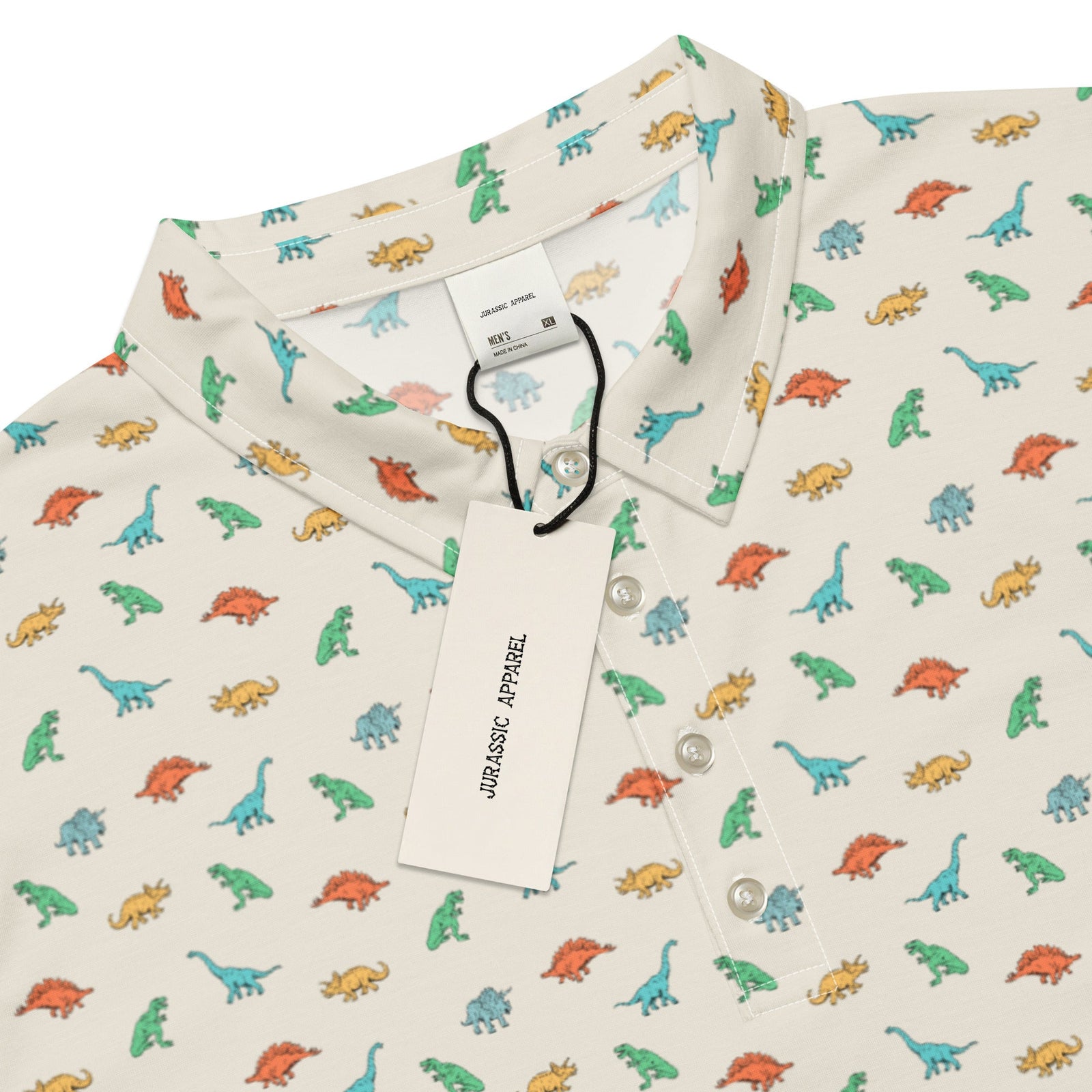Free Shipping On Orders over $75
Free Shipping On Orders over $75
Women's
Men's
Kids
Baby/Toddler
Accessories
Longest-Necked Dinosaurs: The Giants of Prehistory
February 03, 2025 14 min read
Introduction to Long-Neck Dinosaurs

Long-neck dinosaurs, known scientifically as sauropods, were the largest land animals to ever walk the Earth. These herbivorous giants dominated Jurassic and Cretaceous landscapes with their colossal bodies and remarkably elongated necks . Sauropods like Argentinosaurus could reach 30–35 meters in length and weigh up to 60–75 tons , but their most iconic feature was the long neck that balanced a small head on one end and a massive body on the other. This body plan – pillar-like legs, a barrel-shaped torso, a whip-like tail, and a towering neck – evolved early in sauropod history and proved extraordinarily successful.
Why did these dinosaurs evolve such long necks? Paleontologists believe the primary driver was feeding efficiency. A long neck allowed a sauropod to stand in one spot and graze a wide swath of surrounding vegetation, like a living crane sweeping its head through the treetops and across the ground . By not needing to constantly move its enormous body, a sauropod could conserve energy while devouring tons of plants to fuel its bulk . The long neck greatly expanded its “feeding envelope” (the area reachable by the head) , allowing it to gather food from high branches or across a broad area at ground level that other herbivores couldn’t reach.
In evolutionary terms, sauropods’ necks gave them a huge competitive advantage. It’s no surprise this trait evolved multiple times in different sauropod lineages (it wasn’t a one-time fluke) . From the late Triassic into the Jurassic, various early sauropodomorphs experimented with longer necks as they grew in size. Over millions of years, natural selection pushed neck lengths to extremes, culminating in Jurassic giants with necks that still astonish scientists today. In the following sections, we will explore the longest-necked dinosaur ever known, compare other long-necked species, and examine how these gentle giants adapted and thrived. We’ll also look at major fossil discoveries, the latest scientific insights, and the lasting influence of long-neck dinosaurs in popular culture.
The Longest-Necked Dinosaur Ever
When it comes to record-breaking necks, one dinosaur stands above all others: Mamenchisaurus sinocanadorum. This sauropod from Late Jurassic China holds the title for the longest neck ever measured in the fossil record . Its neck is estimated at a staggering 15.1 meters (49.5 feet) long – roughly six times longer than the neck of a giraffe, the tallest land animal today, and even about 3 meters (10 feet) longer than an average school bus . To put that in perspective, just its neck alone was as long as an entire Tyrannosaurus rex. Mamenchisaurus sinocanadorum’s incredibly elongated neck likely makes it the record-holder, at least until any new discovery surpasses it .
Fossil discovery and naming: Despite its gigantic size, the fossil remains of Mamenchisaurus sinocanadorum are few and fragmentary. The first bones of this species were discovered in 1987 during a joint China-Canada expedition in the Shishugou Formation of Xinjiang, northwestern China . Paleontologists uncovered only a handful of parts: a lower jaw, some neck vertebrae, and ribs from the neck region . These were enough to recognize it as a huge sauropod, but at the time its full neck length wasn’t obvious. The species was formally described in 1993 by Dale Russell and Zheng Zhiming, with the name sinocanadorum honoring the China-Canada collaboration .
For years, M. sinocanadorum remained enigmatic due to the limited fossils. No complete neck was found – hardly surprising, since sauropod neck vertebrae are often missing from the fossil record (their bones were lightweight and easily scattered or destroyed) . It wasn’t until 2023 that a new analysis by Dr. Andrew Moore and colleagues used a bit of paleontological detective work to estimate the full neck length with confidence. They compared the known Mamenchisaurus bones to those of a closely related sauropod, Xinjiangtitan, which had an intact neck skeleton, and scaled up the measurements . The result: about 18 cervical vertebrae yielding 15 meters of neck, making Mamenchisaurus sinocanadorum the longest-necked dinosaur scientifically documented .
Physical characteristics: Mamenchisaurus sinocanadorum lived around 160–162 million years ago in the late Jurassic period . Its environment was a lush, floodplain region in what is now Xinjiang, China. Reaching food high in the treetops would have been easy – calculations suggest its head could browse foliage 7.5 to 10 meters off the ground even if the neck was held at a relatively shallow angle . Interestingly, even with such a tremendous neck, Mamenchisaurus sinocanadorum might not have been the heaviest or longest dinosaur overall. It had a relatively small body and tail for its neck length, so it was “all neck” in a sense . Estimates of its total length hover around 26–30 m (much of that being neck), and while it was surely very large, other sauropods like Argentinosaurus or Patagotitan had bulkier builds.
What allowed Mamenchisaurus to grow such a neck? Its vertebrae reveal special adaptations. CT scans show the neck bones were extremely hollow – about 69–77% of their volume was air spaces, much like the bones of modern birds . This made the skeleton lighter (and similar in construction to a crane or radio tower). To maintain strength, each neck vertebra had long bony extensions called cervical ribs (up to 4 meters long) that overlapped with the next vertebra’s ribs, forming a bundle of rods along each side of the neck . These overlapping cervical ribs stiffened and supported the neck, preventing it from sagging under its own weight . Despite its length, the neck was likely held out mostly horizontally (perhaps 20–30° above horizontal) rather than stuck straight up, which would have required immense blood pressure to sustain . Even at a shallow angle, the sheer length gave Mamenchisaurus access to plenty of high foliage .
With M. sinocanadorum crowned as the longest-necked dinosaur known, one might wonder if any other species come close. In the next section, we compare this Jurassic giant to other sauropods famous for their long necks.
Dinosaurs with the Longest Necks
| Dinosaur (Genus) | Estimated Neck Length | Notes |
|---|---|---|
| Mamenchisaurus sinocanadorum | 15.1 m (49.5 ft) | Longest neck on record (Late Jurassic, China). |
| Xinjiangtitan shanshanesis | ~13.4 m (44 ft) | Longest complete neck found (Late Jurassic, China). |
| Sauroposeidon proteles | ~11.5–12 m (37–39 ft) | Extremely tall brachiosaurid-like sauropod (Early Cretaceous, N. America). |
| Supersaurus vivianae | ~11–12 m (36–39 ft) (estimated) | Very large diplodocid; known from partial remains (Late Jurassic, N. America). |
| Brachiosaurus (Giraffatitan) | ~9–10 m (30–33 ft) | High-browsing giraffe-like stance (Late Jurassic, Africa). |
| Barosaurus lentus | ~9 m (30 ft) | Long-tailed diplodocid with elongated neck (Late Jurassic, N. America). |
| Dreadnoughtus schrani | ~11 m (37 ft) | Huge titanosaur; neck ~40% of body length (Late Cretaceous, S. America). |
| Diplodocus carnegii | ~7–8 m (25 ft) | Slender neck and whip-like tail (Late Jurassic, N. America). |
| Apatosaurus (Brontosaurus) | ~6–7 m (20 ft) (estimated) | Stout-bodied diplodocid; neck shorter but very robust (Late Jurassic, N. America). |
Evolution and Adaptation of Sauropod Necks
Evolutionary origins: The long neck of sauropods didn’t appear overnight – it was the result of an evolutionary journey. Early ancestors of sauropods (the “prosauropods” of the Triassic Period, like Plateosaurus) already had moderately elongated necks compared to other reptiles, hinting at the advantages of a longer reach. As sauropods proper evolved in the Jurassic, natural selection consistently favored neck elongation. Interestingly, sauropods inherited a propensity for long necks from their ancestors – even theropod dinosaurs (the lineage that led to birds) were lengthening their necks to some extent . By the time true gigantic sauropods appeared, they had the evolutionary toolkit (small heads, elongated cervical vertebrae, and massive bodies) to truly push neck length to extremes .
One key factor in sauropod neck evolution was the need to eat massive amounts of food. Because sauropods grew to such colossal sizes, they were under pressure to intake huge quantities of foliage daily . A longer neck dramatically increased the feeding envelope, allowing an individual to sweep its head across a broad area and harvest leaves from the treetops down to near the ground without moving its body . This efficient feeding strategy could support a larger body size, creating a positive feedback loop: bigger body → need more food → adaptations for efficient feeding (long neck) → can support even bigger body, and so on. In essence, long necks were a driving force behind sauropod gigantism, enabling these animals to become true leviathans.
However, evolving a neck of record-breaking length also posed challenges. A sauropod with a 10+ meter neck had to solve several anatomical problems:
• Structural support: The neck had to bear its own weight and the head at the end without collapsing. Sauropods addressed this with lightweight construction (hollow bones full of air sacs) and reinforcement (overlapping cervical ribs acting like internal girders) . These features kept the neck strong yet relatively light.
• Blood circulation: Pumping blood all the way up the neck to the brain was no small task. If a sauropod raised its head high, its heart needed to generate very high blood pressure to overcome gravity. There is ongoing debate about how sauropods managed this – they may have had enormous, powerful hearts or accessory “pump” mechanisms, and likely kept their necks at a less vertical angle most of the time to reduce the strain. Computer models suggest many sauropods held their necks outward or at a gentle upward angle (as noted earlier, Mamenchisaurus perhaps at ~20°) , rather than constantly vertical like a giraffe.
• Respiration: With such a long airway, sauropods had to move a lot of air in and out. Fossil evidence shows they had a bird-like respiratory system with air sacs extending into their neck vertebrae . This system not only lightened the bones but also likely allowed unidirectional airflow (like birds have) to make breathing efficient even with a long trachea.
• Neural control and muscles: Maneuvering a long neck required coordination. Sauropods had special adaptations in their neck vertebrae that allowed a wide range of motion. They also had to anchor large neck muscles and ligaments on their shoulders and along the spine. In Apatosaurus, for example, the neck was shorter but very robust, with huge attachment sites for muscles – a different strategy from the slender, elongated neck of Diplodocus . Despite their length, sauropod necks were surprisingly flexible and capable; studies have shown they could sweep their necks with considerable precision to forage .
Why that long? While feeding efficiency is the leading explanation for sauropods’ long necks, scientists have also proposed other possible advantages:
• Thermoregulation: A long neck might have helped in shedding excess body heat by increasing surface area, similar to how large ears help elephants cool down. This idea is speculative, but Dr. Andrew Moore noted that the big neck could have acted as a heat-dissipating structure to some degree .
• Sexual display and combat: Could sauropods have used their necks the way male giraffes do – as visual displays of fitness or even as battering rams in combat? Some paleontologists have considered this. Prof. Paul Barrett points out that an extremely long neck might have been used for “neck-butting” contests between males or for impressive displays to attract mates, analogous to giraffes, though direct evidence is lacking . If two male sauropods swung or pushed against each other with their necks, the stronger-necked individual might win disputes. This hypothesis is hard to prove but remains an intriguing possibility.
• Niche partitioning: Within ecosystems that had multiple sauropod species, differences in neck length and feeding height could reduce competition. For instance, in the Late Jurassic Morrison Formation (western North America), Brachiosaurus (tall, long forelimbs, likely browsing high in the canopy) coexisted with Apatosaurus and Diplodocus (which may have fed mid-level or low to the ground). By having varying neck lengths and feeding postures, these giants could “divide” the available food resources by height, each specializing in a different leafy strata. Evolution would then favor longer necks in some lineages to exploit higher foliage, and perhaps longer necks in others to reach further without moving.
In summary, sauropod necks represent a marvel of evolution – a balance of biomechanical innovation (hollow bones, air sacs, strong yet light structure) and ecological strategy (efficient feeding and possibly other roles). Through natural selection, sauropods continually tested the limits of how long a neck could grow without compromising function. Mamenchisaurus and kin show that the limit was very high indeed, though there were certainly trade-offs. We have yet to find the absolute maximum – there is always a chance a future fossil could reveal an even longer neck – but for now these Jurassic titans illustrate how evolution engineered the longest necks in Earth’s history.
Fossil Discoveries and Scientific Insights
The story of long-necked dinosaurs is also a story of scientific discovery. From the Bone Wars of the 19th century to high-tech analyses of the 21st, paleontologists have been unearthing clues about sauropods and piecing together how these giants lived.
Historical discoveries: The first sauropod fossils to capture public attention were discovered in the late 1800s in North America’s Morrison Formation. In 1877, Othniel C. Marsh described Apatosaurus (initially calling a later specimen “Brontosaurus”), and soon after described Diplodocus and Camarasaurus – opening the world’s eyes to gigantic long-necked dinosaurs in the American West . Rival paleontologist Edward D. Cope also named large sauropods (like Amphicoelias, though that evidence was scant). This frenzy of fossil hunting (the “Bone Wars”) led to the first mounted sauropod skeletons in museums. By 1905, Diplodocus skeletons (casts of Diplodocus carnegii, sponsored by Andrew Carnegie) were being unveiled in museums in Pittsburgh, London, Paris, and beyond, fascinating the public with a dinosaur that had a graceful 80+ ft body and a long neck and tail.
Around the same time, in 1900–1910, German expeditions to Tendaguru, Tanzania led by Werner Janensch uncovered spectacular sauropod remains, including what was then named Brachiosaurus brancai. This African giant (now often reclassified as Giraffatitan) had a long neck held aloft by its taller front limbs, reinforcing the image of sauropods as “towering” dinosaurs. The Tendaguru expeditions remains one of the most productive sauropod digs, yielding multiple long-neck species.
In Asia, sauropod discoveries picked up mid-20th century. In the 1950s, Chinese paleontologists unearthed Mamenchisaurus in Sichuan Province (the name means “Mamenxi [Horse Gate] lizard” after the site) , which proved to have a very long neck (the species M. hochuanensis had 19 cervical vertebrae and a ~9 m neck). Later, the Sino-Canadian expeditions of the 1980s led to Mamenchisaurus sinocanadorum (our record-holder). Fossils from Argentina (like Argentinosaurus and Dreadnoughtus in the late 20th and early 21st century) expanded our view, showing titanosaurs with immense bodies and long necks in the Southern Hemisphere.
Fossil sites: Some key fossil sites for long-necked dinosaurs include:
• The Morrison Formation (USA) – Late Jurassic deposits across Colorado, Utah, Wyoming, etc., yielding Apatosaurus, Diplodocus, Barosaurus, Camarasaurus, Brachiosaurus, and others. Quarry sites like Dinosaur National Monument have produced multiple articulated skeletons.
• Tendaguru (Tanzania) – Late Jurassic site yielding Giraffatitan, Dicraeosaurus, and others, excavated 1907–1912.
• Shaximiao & Shishugou Formations (China) – Late Jurassic rocks in China yielding Mamenchisaurus (several species) and Xinjiangtitan among other sauropods. For instance, M. sinocanadorum came from the Shishugou Formation .
• Cloverly and Antlers Formations (USA) – Early Cretaceous of Oklahoma/Texas, where Sauroposeidon vertebrae were found in the 1990s .
• Patagonia sites (Argentina) – Late Cretaceous locales like the Cerro Fortaleza Formation that produced Dreadnoughtus (discovered 2005) and formations yielding Argentinosaurus (discovered 1980s). These sites showed sauropods remained enormous until the end of the dinosaur era.
Scientific insights and techniques: Each new discovery required scientists to interpret often incomplete remains. Sauropod paleontology has benefited from advances in technology and methodology:
• Researchers now use CT scanning and 3D modeling to look inside sauropod bones. For example, the team studying Mamenchisaurus sinocanadorum CT-scanned its vertebrae and quantified the air space, confirming the neck bones were extremely pneumatic (hollow) . This helps paleontologists understand weight distribution and biomechanics.
• Comparative analysis is crucial. Since we rarely find a whole skeleton, scientists compare incomplete specimens with relatives. Mamenchisaurus’s neck length was calculated by comparing with Xinjiangtitan’s complete neck and adjusting for size . This approach, while indirect, is backed by phylogenetic bracketing (knowing Mamenchisaurus and Xinjiangtitan are close kin).
• Biomechanical modeling: Paleontologists like Dr. Michael Taylor and Dr. Mathew Wedel (experts on sauropod necks) have modeled how sauropod necks could move and what angles they likely held. These studies combine mechanical engineering principles with fossil anatomy. For instance, studies have suggested that sauropods like Mamenchisaurus and Diplodocus most likely kept their necks inclined at low angles most of the time , and could sweep them side to side to cover ground efficiently when feeding.
• Insights from bone microstructure and growth rings have shown sauropods grew rapidly to achieve such great size, reaching near adult sizes in a couple of decades. A larger body in turn influences neck growth and support – these aspects are part of understanding sauropod life history.
• Paleogeography and evolution: Discoveries in different continents inform how sauropods dispersed and evolved. The presence of very long-necked mamenchisaurids in Asia vs. long-necked but differently built diplodocids in North America during the Jurassic indicates separate evolutionary experiments in neck elongation. Titanosaurs in the Cretaceous (like Dreadnoughtus) also evolved long necks independently . Scientists piece together these evolutionary paths to see a pattern: repeated evolution of long necks whenever it conferred a feeding advantage, across different times and places.
Notable paleontologists in the study of sauropods include those early bone hunters (Marsh, Cope, Janensch), as well as modern researchers. Dr. Paul Upchurch has contributed much to sauropod evolutionary studies (and co-authored the recent Mamenchisaurus neck study, providing context on how it held its neck) . Dr. Andrew Moore led the 2023 study pinpointing Mamenchisaurus as the longest neck and exploring its anatomy in detail . Their work, along with many others, continues to unravel the mysteries of sauropod biology. As Dr. Ye Yong (of the Zigong Dinosaur Museum in China) remarked, even very incomplete specimens like Mamenchisaurus sinocanadorum can teach us a great deal about sauropod evolution . With every new fossil and new technology, we gain insight into how these extraordinary animals functioned.
Popular Culture and Influence
Long-necked dinosaurs have captured the public’s imagination for over a century, earning a special place in popular culture. Their awe-inspiring size and gentle giant reputation make them favorites in movies, literature, and museums. Here are a few ways sauropods (the “long-necks”) have influenced popular culture:
• Classic Films and Animation: Sauropods have starred in family films and animated features for generations. In the 1989 animated film The Land Before Time, a young Apatosaurus nicknamed “Littlefoot” leads the story – the movie lovingly calls his kind “Longnecks,” reflecting how children often identify these dinos by their necks. Littlefoot’s character introduced sauropods as sympathetic, friendly giants to millions of kids. Another iconic appearance is in Jurassic Park (1993), where a majestic Brachiosaurus is the first dinosaur seen by the park’s visitors. The scene of the Brachiosaurus rearing on its hind legs to munch leaves from a tall tree, set to wonder-filled music, became an unforgettable moment in cinema. It showcased the immense height and reach of a long-neck dinosaur, firmly imprinting the Brachiosaurus in pop culture.
• Nicknames and Misnomers: For decades, the name “Brontosaurus” was commonly used in books, cartoons, and toys to represent the quintessential long-neck dinosaur. Even though scientists had determined by the 1900s that Brontosaurus was really Apatosaurus (and the name was deprecated for a while), the image of “Bronto the thunder lizard” lived on. From Gertie the Dinosaur (a 1914 animated short featuring a lovable Brontosaurus) to the Sinclair Oil Company’s Brontosaurus logo, the long-neck dino became an emblem of dinosaurs as a whole. Interestingly, in 2015, researchers actually argued that Brontosaurus was distinct enough from Apatosaurus to revive the name – to the delight of a nostalgic public. Regardless of nomenclature, the long neck and long tail silhouette is what people picture when they hear “dinosaur.”
• Museums and Exhibits: Towering sauropod skeletons are centerpieces in many natural history museums, inspiring awe in visitors. For example, “Dippy” the Diplodocus – an enormous cast of Diplodocus bones – greeted visitors in the entrance hall of London’s Natural History Museum for decades (from 1905 until recently). Dippy became so popular that it went on a tour around the UK, drawing crowds wherever it went. The American Museum of Natural History in New York famously unveiled a cast of a 37-meter Patagotitan (a titanosaur sauropod) in 2016, so large that its neck and head poke out towards the mezzanine because it doesn’t fully fit in the gallery! These displays allow the public to stand under a sauropod’s neck and truly feel its magnitude. Children and adults alike often pose for photos next to the leg bones or try to imagine reaching the head 9 meters up. Such exhibits reinforce how extraordinary these animals were and keep them in the public eye.
• Literature and Education: Sauropods feature in countless children’s books, often under affectionate monikers like “long-necks.” They are usually portrayed as peaceful plant-eaters, emphasizing their gentle nature despite their size. In science fiction literature, sauropods occasionally appear as well – for instance, Anne McCaffrey’s “Permian Longneck” in her Dinosaur Planet novels. Educational programs and documentaries, from BBC’s Walking with Dinosaurs (which vividly brought Diplodocus and Brachiosaurus to life on screen) to Disney’s Dinosaur (2000) film featuring a brachiosaur-like character named Baylene, all showcase sauropods as an integral part of the prehistoric world narrative.
• Symbol of the Dinosaur Era: Long-necked dinosaurs often serve as an iconic symbol of the Age of Dinosaurs. Images of a serene sauropod herd at sunset or a lone brachiosaur silhouette against Jurassic conifers are frequently used in art and media to evoke the Mesozoic. Because they were some of the largest animals to ever live, sauropods represent “dinosaur grandeur.” They even find their way into music and games; the popular video game Ark: Survival Evolved features a tamable sauropod simply called “Bronto,” and the Pokémon franchise has a long-necked creature (Alamosaurus-inspired) named Tropius. Their cultural footprint is as giant as their physical one.
In all these ways, long-neck dinosaurs have transcended scientific circles to become beloved giants in our collective imagination. They continue to educate and inspire, serving as ambassadors for paleontology. Whether through a child’s toy brontosaur, a CGI giant on the big screen, or a skeleton in a museum, the allure of the sauropod’s long neck endures.














